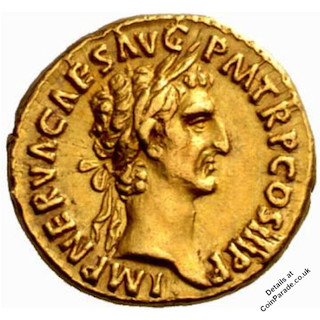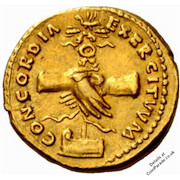
 The 97AD Gold Aureus - Nerva / Concordia Exercituum
The 97AD Gold Aureus - Nerva / Concordia ExercituumGold Aureus of Emperor Nerva, minted around 97AD.
The Obverse shows the laureated head of Emperor Nerva facing right.
Legend is "IMP. NERVA CAES. AVG. P. M. TR. P., CO[N]S. III, P. P.", a contraction of "IMPerator NERVA CAESar AVGustus Pontifex Maximus TRibunus Plebis COnSul III Pater Patriae".
The Reverse shows clasped right hands holding an Aquila. The symbol of two clasped hands over an army standard shows the unity between the Emperor and the Roman Army.
 Legend is "CONCORDIA EXERCITVVM" meaning "Harmony with the army".
Legend is "CONCORDIA EXERCITVVM" meaning "Harmony with the army".Image credit: CNG Coins
Click to Check these on eBay.
As an eBay Partner, We may be compensated if you make a purchase
(scroll to bottom for more)
As an eBay Partner, We may be compensated if you make a purchase
(scroll to bottom for more)
List items on:
Mintage: Not known
Minted at Roman Mint.
Nerva (Emperor 96AD-98AD)
Classification: Roman Emperor, Roman, Nerva–Antonine DynastyNerva became Roman Emperor when he was almost 66 years-old and ruled from 18 September 96AD until 27 January 98AD. Not that much is known about him. He served under Nero and most of the Flavian dynasty. When Emperor Domitian was assassinated by members of the Praetorian Guard, Nerva was declared Emperor by the Roman Senate.
Nerva (born 8 November 30AD) only had a brief reign as he died from natural causes on 27 January 98AD, aged 67. Before dying he adopted Trajan as the next Emperor which was a very popular choice and led to the founding the Nerva–Antonine dynasty (96-192AD).
Nerva is thought of as the first of the "Five Good Emperors" (Nerva, Trajan, Hadrian, Antoninus Pius, and Marcus Aurelius). After his death he was deified by Trajan.
Regnal name: Imperator Nerva Caesar Augustus
MARCVS COCCEIVS NERVA CAESAR AVGVSTVS
Category: Roman
The Roman Empire was one of the largest Empires in history, covering most of Europe, Britain, parts of Asia, the Middle East and North Africa. It was in existence from 27BC to 476AD, more than 500 years. And all these places used Roman coins throughout the era.Originally coins were minted only in Rome, but by the third Century there were mints in other countries too. These mints sometimes produced more than 2 million coins per month to meet demand. Coins typically depicted the Emperor on one side and some other image or letters on the other. During the Empire, more than 10,000 different types of coins were created using copper, silver and gold.
Roman coins are usually classified as:
- Roman Republican Coins (about 300BC - 27BC)
- Roman Imperial Coins (27BC - 96AD)
- Roman Imperial Coins (96AD - 235AD)
- Roman Imperial Coins (235AD - 476AD)
- Roman Provincial Coins
The Denarius was the standard Roman silver coin and there were a range of others. As a guide, in the early republic (after 211BC) there was the Sestertius (=4 denarii), Dupondius (=5), As (=10, a tenner), Semis (=20), Quincunx (=24), Triens (=30), Quadrans (=40), Uncia (=120) and Solidus (=1000, it was gold). Values fluctuated later due to debasement and inflation.
The standard gold coin was the Aureus and was equal to 25 denarii or 100 sestertii. It's not far off the weight of a modern gold sovereign. The Aureus was introduced by Julius Caesar around 49BC and was the principal gold coin until about the 4th century when it was replaced by the gold Solidus.
The great part of this is that you can put together a really nice Roman coin collection with very little money, as many coins (although not all) are common and inexpensive. The coins are the best part of 2000 years old and are exciting to collect.
For more information see our articles:
Which Mint: Roman Mint
The origins of the Rome mint are from the manufacture of a silver coin near to the Temple of Juno Moneta back in 269BC. Juno was the personification of money.Due to the size of the Roman Empire, Rome could not produce all the coins needed and Roman mints were set up in 27 locations, and there were more than 600 provincial mints scattered about the Empire. During overseas campaigns, Generals such as Caesar and Marc Anthony would mint their own coins to pay their armies.
Mint marks were used on the coins to differentiate the mint of manufacture.
Country of Origin: Roman Empire
The Roman Empire ran from 27BC to 476AD and was the post-Republican period of ancient Rome. It covered a large territory of Europe, Northern Africa, and Western Asia. It was ruled by an Emperor.If you don't see a coin in the list below try the Roman page on eBay UK
As an eBay Partner, We may be compensated if you make a purchase.
As an eBay Partner, We may be compensated if you make a purchase.
List items on:
List items on:








